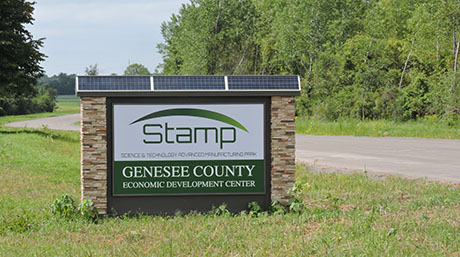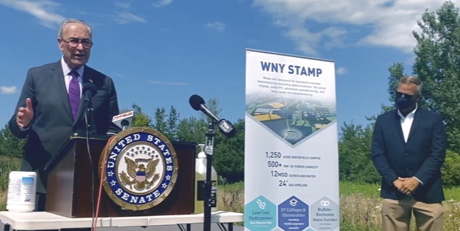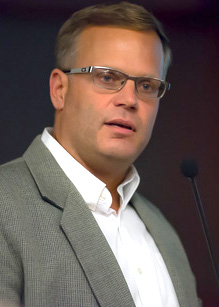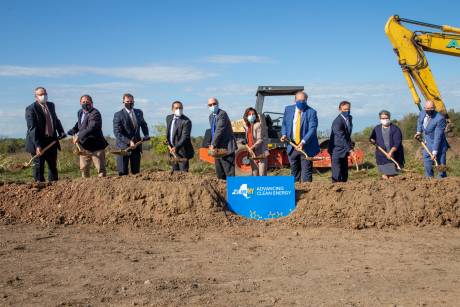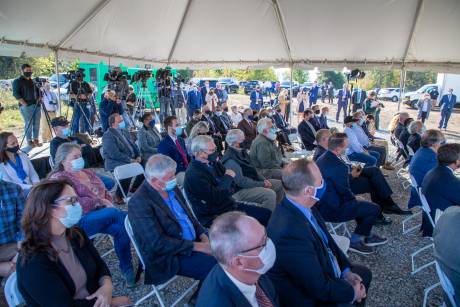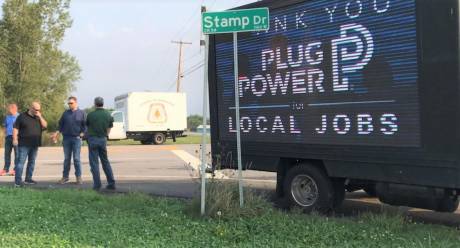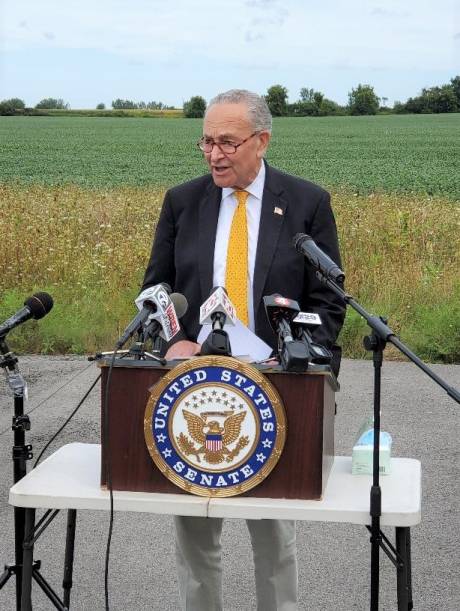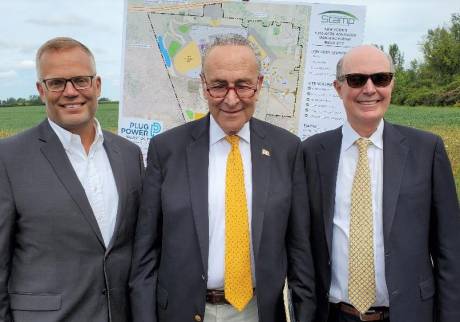Press release:
Standing with Rochester Finger Lakes Region business and economic development leaders on Wednesday, U.S. Senate Majority Leader Charles E. Schumer re-upped his push for the Senate to pass his bold, bipartisan initiative next week to propel American leadership in science and technology into the 21st century.
The legislation is in the debate process on the floor of the Senate.
Schumer’s plan – which includes passing the Endless Frontier Act, now part of the broader U.S. Innovation and Competition Act, provides $52 billion in federal investment to fully fund the implementation of the bipartisan semiconductor provisions he passed in last year’s defense bill.
It would dramatically increase U.S. investment in domestic advanced manufacturing and research & development of strategically important technologies like semiconductors and establish regional tech hubs across the country.
These investments could help lead to the creation of new jobs and jumpstart innovation across Rochester and Western New York.
Senator Schumer said these new investments would both supercharge work by the region’s key economic development drivers, including the University of Rochester (UR) and Rochester Institute of Technology (RIT), to invest in new technological research and development that spur new jobs and businesses as well as support the region’s semiconductor manufacturers (like Akoustis Technologies in Candandaigua) and attract new semiconductor factories to the region’s STAMP business park in Alabama.
“We must immediately address several dangerous weak spots in our country’s competitiveness that threaten America’s global technological leadership. We’re in an all-out race for the jobs of the future and to protect our country’s global technological edge and it’s time to put New York’s top-tier workforce and tech community on the frontlines” Senator Schumer said.
“This legislation will enhance American competitiveness with China and other countries by building up places across Rochester and Western New York to lead in the innovation economy, creating high-tech American manufacturing jobs, strengthening R&D, and investing in workforce training capabilities.
“The stakes are enormous. If we do not invest now in the research, development, and manufacturing of technologies of the future, we risk falling behind in the race with China and other global competitors, putting at risk U.S. jobs, intellectual property, and national security.”
Today, the United States’ position as the unequivocal global leader in scientific and technological ingenuity and innovation is under pressure from China and is eroding. U.S. competitiveness and national security are being threatened by decades of U.S. underinvestment in research, manufacturing, and workforce development, coupled with foreign competitors stealing American intellectual property and aggressively investing to dominate the key technology fields of today and of the future.
Schumer said that without a significant and sustained increase in investment in research, education and training, technology transfer and entrepreneurship, manufacturing, and the broader U.S. innovation ecosystem across the nation, it is only a matter of time before America’s global competitors overtake the United States in terms of technological primacy, threatening national security and economic prosperity.
He cited a recent study authored by MIT Economists Jonathan Gruber, Ph.D., and Simon Johnson in their book, "Jump-Starting America: How Breakthrough Science Can Revive Economic Growth and the American Dream," that concluded millions of new jobs could be created through a new federal effort to boost federal funding for the sciences.
They analyzed 102 regions to determine which are best poised to become new Tech-Economy hubs if provided federal scientific research & development investment and determined that Rochester ranked No. 1 as the nation's top region ripe for technological and economic growth. The authors argued for the creation of a bold new federal investment in science and technology, such as would be created now through the U.S. Innovation and Competition Act.
Additionally, Schumer highlighted the region’s STAMP business park (Science Technology & Advanced Manufacturing Park) as a site that can be positioned to attract new semiconductor supply chain or chip fab manufacturing facilities thanks to the U.S. Innovation and Competition Act.
In recent months he has personally urged the top brass at Samsung, Intel, and Micron to look to locate their next U.S. chip production facilities in New York, said the legislation’s provisions to provide $52 billion in emergency spending to implement Federal incentives to semiconductor companies in return for building new chip fabs in the United States is already a game-changer, creating new opportunities for places like STAMP to attract new semiconductor jobs and factories and for companies like Akoustis Technologies to expand.
Schumer’s plan is in the process of debate on the floor of the Senate and includes his "Endless Frontier Act." The plan would invest in three main areas – domestic advanced manufacturing; research, development, entrepreneurship, and workforce training in strategically important technologies like semiconductors; and establishing regional technology hubs through federal investment in economic development across the country to be global tech centers.
Schumer is also proposing $52 billion in emergency supplemental appropriations to implement the bipartisan federal semiconductor manufacturing and R&D provisions he passed into law last year as part of the annual defense bill.
Details on the supplemental appropriations proposed by Senator Schumer appear below:
- $49.5 billion allocated over five years for a CHIPS for America Fund. Funding must be used to implement the Commerce Department semiconductor incentive and R&D programs authorized by the FY21 NDAA (Sec. 9902 & 9906). Within the fund, the following appropriations are available:
-- Incentive Program: $39 billion appropriated upfront and allocated over five years to implement the programs authorized in Sec. 9902. $2 billion is provided to solely focus on legacy chip production to advance the economic and national security interests of the United States, including helping to address the chip shortage faced by the auto industry.
$19 billion in FY22, including the $2 billion legacy chip production funding;
$5 billion each year, FY23 through FY26
- Commerce R&D programs: $10.5 billion appropriated upfront and allocated over five years to implement programs authorized in Sec. 9906, including the National Semiconductor Technology Center (NSTC), National Advanced Packaging Manufacturing Program, and other R&D programs authorized in Sec. 9906.
-- $5 billion in FY22
-- $2.5 billion for advanced packaging
-- $2 billion for NSTC
-- $500 million for other related R&D programs
For use across the advanced packaging, NSTC, and other related R&D programs, the following would be provided:
-- $2 billion in FY23
-- $1.3 billion in FY24
-- $1.1 for FY25 and FY26
- $2 billion for a CHIPS for America Defense Fund: Funding is appropriated up front and $400 million is allocated each year, over five years for the purposes of implementing programs authorized in Sec. 9903(b), providing support for R&D, testing and evaluation, workforce development, and other related activities, in coordination with the private sector, universities, and other Federal agencies to support the needs of the Department of Defense and the intelligence community.
- $500 million for a CHIPS for America International Technology Security and Innovation Fund: Funding is appropriated upfront and $100 million each year, allocated over five years to the Department of State, in coordination with the U.S. Agency for International Development, the Export-Import Bank, and the U.S. International Development Finance Corporation, for the purposes of coordinating with foreign government partners to support international information and communications technology security and semiconductor supply chain activities, including supporting the development and adoption of secure and trusted telecommunications technologies, semiconductors, and other emerging technologies.
An additional $1.5 billion is provided for implementation of implement the USA Telecommunications Act that was also passed as part of last year’s NDAA to foster U.S. innovation in the race for 5G.
Details on the Endless Frontier Act
As reported by the Senate Commerce Committee, it seeks to maintain and build on U.S. science and technology leadership through investments in research and development and strengthening regional economic development, manufacturing, and supply chains. The legislation would authorize roughly $120 billion over five years for activities at the National Science Foundation (“NSF”), Department of Commerce (“DOC”), the Department of Energy (“DOE”), and the National Aeronautics and Space Administration (“NASA”).
It advances priorities including to reduce undue geographic concentration of R&D funding, encourage broader participation of populations underrepresented in STEM, and increase collaboration across federal agencies and with nongovernmental partners on innovation. Crucially, the Endless Frontier Act helps to bridge the gap of innovative technological breakthroughs happening at America’s premier research institutions by bringing those breakthrough to the applied science and commercialization space to benefit our countries growing innovative advancements.
Notable Provisions
Technology Directorate: The Endless Frontier Act would create a new Directorate of Technology and Innovation at the NSF to support research and technology development in key technology focus areas, such as artificial intelligence and quantum science, in order to strengthen the global leadership of the United States in innovation. Major activities would include funding research and development at collaborative institutes, supporting academic technology transfer and intellectual property protection, establishing technology testbeds, and awarding scholarships and fellowships to build the relevant workforce. The Directorate would be authorized at $29 billion over fiscal years 2022 to 2026, including a transfer of $2.9B to existing NSF divisions to support basic research collaboration.
NSF Research and Development Programs: The Endless Frontier Act would authorize $52 billion over fiscal years 2022 to 2026 for existing NSF activities, representing a 7-percent increase each year. The legislation would also create a Chief Diversity Officer at NSF and increase STEM education to enhance the domestic STEM workforce. The legislation also incorporates a series of new programs, including programs for precision agriculture, rural STEM education, quantum information science, skilled technical education, critical minerals, and bioeconomy R&D.
Regional Technology Hubs: The Endless Frontier Act creates a regional technology hub program at DOC to support regional economic development in innovation. Technology hubs would carry out workforce development activities, business and entrepreneur development activities, technology maturation activities, and infrastructure activities related to the technology development. The technology hubs program would be authorized at $10 billion over fiscal years 2022 to 2026.
Manufacturing: The Endless Frontier Act would authorize close to a quadrupling of the DOC Manufacturing Extension Partnership and create a new track within the program for public benefit activities like workforce development and cybersecurity services. The Manufacturing Extension Partnership would be funded at $2.4B over fiscal years 2022 to 2026. The substitute would also authorize the Manufacturing USA program, at $1.2B over fiscal years 2022 to 2026, and add workforce and coordination provisions.
Supply Chain Resiliency: The Endless Frontier Act would establish a supply chain resiliency program at the Department of Commerce to work with the private sector, for the purpose of identifying and recommending opportunities to mitigate or address supply chain vulnerabilities in the United States and in allied and partner countries. It would also amend the recently enacted CHIPS Act to provide $2 billion in incentives for domestic production of mature semiconductor technologies, such as for the automotive industry.
Schumer’s plan also includes $52 billion in emergency supplemental appropriations to implement the bipartisan federal semiconductor manufacturing and R&D provisions he passed into law last year as part of the annual defense bill. An additional $1.5 billion is provided for implementation of implement the USA Telecommunications Act that was also passed as part of last year’s NDAA to foster U.S. innovation in the race for 5G.
Steve Hyde, president & CEO, Genesee County Economic Development Center, said “Senate Majority Leader Schumer has long-championed Upstate New York as the ideal region for critical growth of the domestic semiconductor manufacturing and R&D investments due to our university research and talent, our established and ever-growing semiconductor supply chain, along with our considerable capacity of renewable, reliable, and competitively priced electricity. We applaud Senator Schumer for his leadership, and agree that passage of the U.S. Innovation and Competition Act would be catalytic in growing the high-tech economy at the Western New York Science & Technology Advanced Manufacturing Park (STAMP) and all across Upstate New York."
Schumer added, “These investments are key to preserving America’s position on the world stage as a current and future technological leader. In the coming days, I will push for final Senate passage of this legislation to ensure that the U.S.’ hand at home and abroad is as strong as possible as we compete with China on all fronts.”

